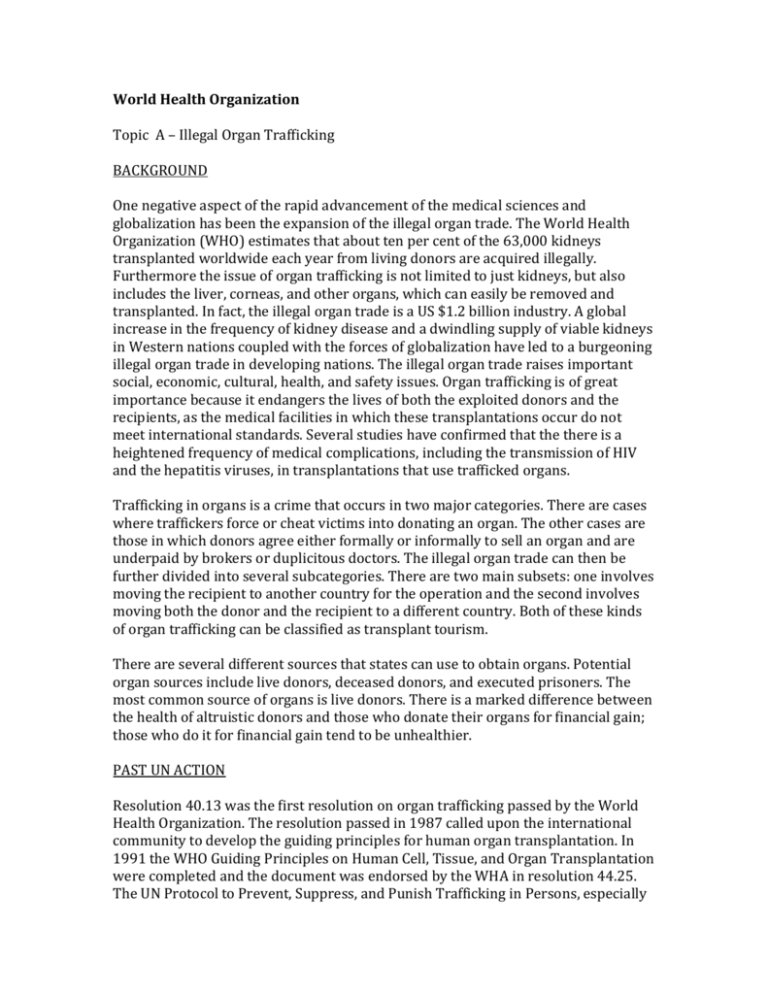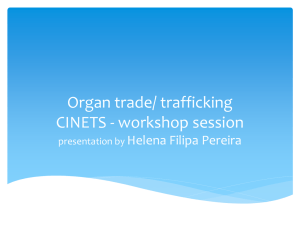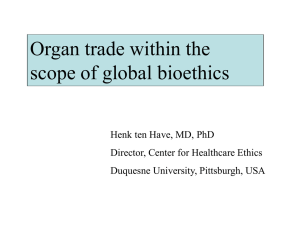WHO Topic A – Organs
advertisement

World Health Organization Topic A – Illegal Organ Trafficking BACKGROUND One negative aspect of the rapid advancement of the medical sciences and globalization has been the expansion of the illegal organ trade. The World Health Organization (WHO) estimates that about ten per cent of the 63,000 kidneys transplanted worldwide each year from living donors are acquired illegally. Furthermore the issue of organ trafficking is not limited to just kidneys, but also includes the liver, corneas, and other organs, which can easily be removed and transplanted. In fact, the illegal organ trade is a US $1.2 billion industry. A global increase in the frequency of kidney disease and a dwindling supply of viable kidneys in Western nations coupled with the forces of globalization have led to a burgeoning illegal organ trade in developing nations. The illegal organ trade raises important social, economic, cultural, health, and safety issues. Organ trafficking is of great importance because it endangers the lives of both the exploited donors and the recipients, as the medical facilities in which these transplantations occur do not meet international standards. Several studies have confirmed that the there is a heightened frequency of medical complications, including the transmission of HIV and the hepatitis viruses, in transplantations that use trafficked organs. Trafficking in organs is a crime that occurs in two major categories. There are cases where traffickers force or cheat victims into donating an organ. The other cases are those in which donors agree either formally or informally to sell an organ and are underpaid by brokers or duplicitous doctors. The illegal organ trade can then be further divided into several subcategories. There are two main subsets: one involves moving the recipient to another country for the operation and the second involves moving both the donor and the recipient to a different country. Both of these kinds of organ trafficking can be classified as transplant tourism. There are several different sources that states can use to obtain organs. Potential organ sources include live donors, deceased donors, and executed prisoners. The most common source of organs is live donors. There is a marked difference between the health of altruistic donors and those who donate their organs for financial gain; those who do it for financial gain tend to be unhealthier. PAST UN ACTION Resolution 40.13 was the first resolution on organ trafficking passed by the World Health Organization. The resolution passed in 1987 called upon the international community to develop the guiding principles for human organ transplantation. In 1991 the WHO Guiding Principles on Human Cell, Tissue, and Organ Transplantation were completed and the document was endorsed by the WHA in resolution 44.25. The UN Protocol to Prevent, Suppress, and Punish Trafficking in Persons, especially Women and Children was adopted by the General Assembly in 2000 and entered into force in 2003. In October 2003, clinicians, ethicists, scientists, and government officials from twenty-three countries, representing all WHO regions met in Madrid and analyzed the issue of organ transplantation. The findings of this summit were published in the Madrid report. These summits produced resolution 57.18, which was passed in 2004. The resolution urged states to increase the organ supply through the use of both live donors and deceased donors in order to meet patient needs. The protocol addresses many of the important questions regarding the organ trade and serves as the ideal foundation for a comprehensive resolution on this topic QUESTIONS TO CONSIDER 1. Are the ethical issues of consent and self-autonomy dictated by your country’s culture? 2. Are there clearly defined codes of conduct for health care facilities and medical professionals regarding unregulated paid organ donations? 3. How do we protect the most vulnerable populations from not being duped into becoming organ donors by duplicitous doctor and organ brokers? 4. What responsibility do doctors, medical professionals, and healthcare facilities have in the prevalence of organ trafficking? FURTHER INFORMATION http://www.who.int/transplantation/en/ http://www.declarationofistanbul.org/ http://journals.lww.com/transplantjournal/Fulltext/2011/06151/Report_of _the_Madrid_Consultation__Part_1_.6.aspx http://cofs.org/home/ http://www.who.int/bulletin/volumes/85/12/06-039370/en/ http://www.ungift.org/knowledgehub/en/about/trafficking-for-organtrade.html








